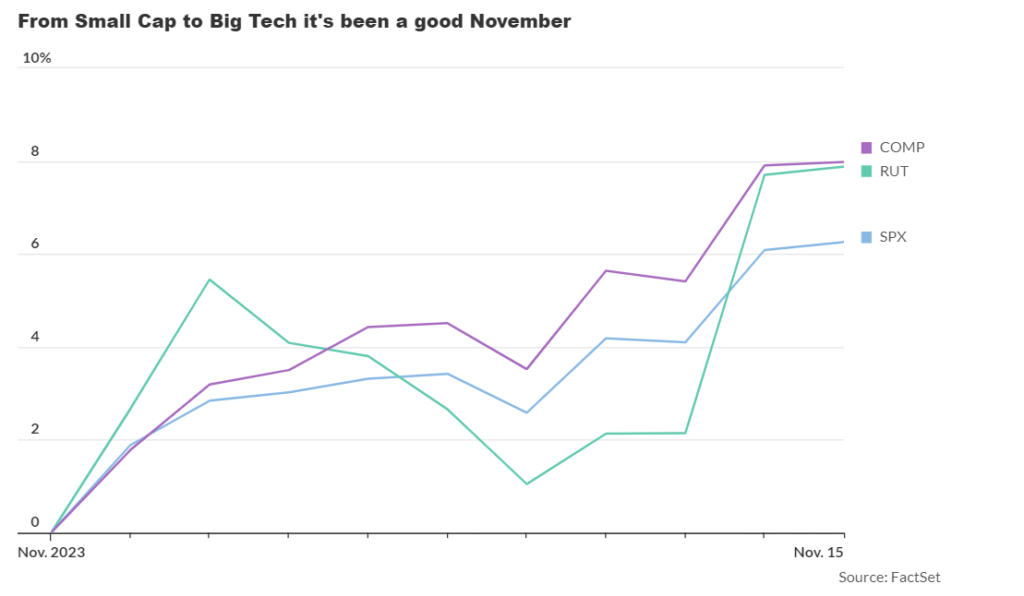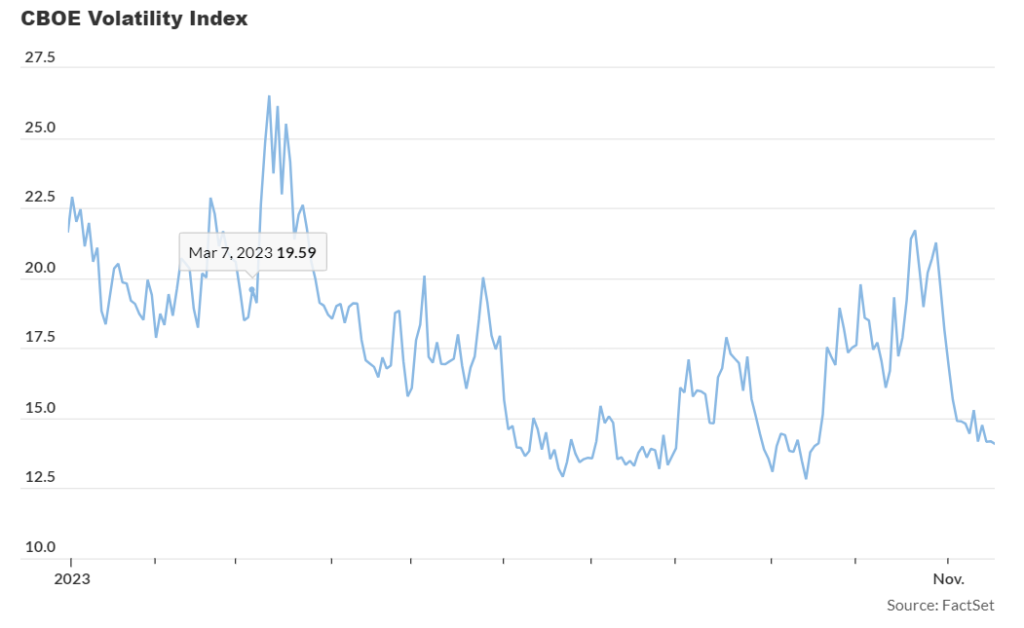Early Thursday, U.S. stock futures remained mostly unaffected, staying close to their peak of the past two months, with traders reflecting on the recent impressive surge.
How are stock-index futures trading
- The S&P 500 futures, specifically ES00, declined by 2 points or 0%, reaching a value of 4517.
- The futures of the Dow Jones Industrial Average, represented by the symbol YM00, dropped by 5 points or 0%, reaching a value of 35045.
- The Nasdaq 100 futures, also known as NQ00, decreased by 32 points or 0.2%, reaching 15857.
The Dow Jones Industrial Average went up by 164 points, or 0.47%, reaching 34991 on Wednesday. The S&P 500 saw an increase of 7 points, or 0.16%, bringing it to 4503. Similarly, the Nasdaq Composite rose by 9 points, or 0.07%, ending at 14104.
What’s driving markets
The futures market suggests that stock market indexes are currently stabilizing following a period of positive performance.
The S&P 500 is currently at its highest point since September 14th, having increased in value for 11 out of the last 13 sessions. It has gained 7.4% so far this month. The Nasdaq Composite, which focuses on technology stocks, has risen in value for 12 out of the last 14 days and has experienced a 9.75% increase in November. The Russell 2000 index, which tracks small cap stocks, has seen an 8.4% increase during the same time period.
Rallies are largely fueled by the decrease in borrowing expenses. In the past month, the 10-year Treasury yield has dropped from a 16-year peak of over 5% to 4.50%. This decline is attributed to optimistic expectations that a slowdown in the U.S. job market and reduced inflation will prompt the Federal Reserve to initiate interest rate cuts by mid-2022.
At the same time, investors are growing more assured that the Federal Reserve’s gradual increase of around 500 basis points in interest rates during this period will not lead to a significant downturn in the American economy. They believe that even if there is a gentle economic slowdown, it will still provide enough support for companies to maintain their earnings.
Nevertheless, there are some experts warning to be cautious as the CBOE VIX index, which measures expected market volatility, is approaching 14 again and the S&P 500’s 14-day relative strength index has quickly shifted from indicating overselling to nearing overbought within a span of three weeks.
Stephen Innes, managing partner at SPI Asset Management, stated that stock futures were showing a lackluster start due to worries that the market has advanced too rapidly.
“The main concern for the markets is whether traders and investors have acted too quickly in assuming that the recent string of weak macro data in the United States will lead to the Federal Reserve implementing a policy to ease economic conditions starting in the later part of the first quarter of 2024. Innes stated that there is a worry that the markets are now exaggerating the probability of the Federal Reserve fully accommodating the current situation.”
After the market closed on Wednesday, Cisco Systems CSCO released disappointing results, causing the company’s stock to decline by over 10%. This incident served as a reminder of the fragility of the market.

Before the start of the trading day, Walmart, Macy’s, and Williams-Sonoma will release their financial results. Meanwhile, Applied Materials, Gap, and Beazer Homes will announce their earnings after the market closes.
Mark Newton, the technical strategy leader at Fundstrat, expressed his approval of the recent development in the equity market, where a larger number of shares have been participating in the rally. He noted that the gains are not solely dependent on big tech stocks, which is a positive sign. Newton believes that this increase in breadth has the potential to continue driving the market forward in the days ahead.
However, he mentioned that even though there may be short-term market conditions where the buying of stocks exceeds a reasonable level, this is part of a negative trend which can be seen in the weekly and monthly charts. This suggests that any increases in the stock market next week will likely face strong resistance. Thus, the potential benefits of investing in US Equities in the short-term may not be as favorable if there is another increase in value next week.

On Thursday, there will be new information about the U.S. economy. This will include reports on the number of people filing for unemployment benefits for the first time in the week, the price index for imported goods in October, and a survey on manufacturing activity in Philadelphia in November. These reports will be available at 8:30 am Eastern Time.
The release of October’s industrial production and capacity utilization is scheduled for 9:15 a.m., and it will be followed by the release of November’s home builder confidence at 10 a.m.
On Thursday, a significant group of officials from the Federal Reserve will be delivering speeches. These include Loretta Mester, the President of the Cleveland Fed, speaking at 8:30 a.m.; John Williams, the President of the New York Fed, speaking at 9:25 a.m.; Michael Barr, the Vice Chair for Supervision at the Fed, speaking at 10:35 a.m.; and Lisa Cook, a Governor at the Fed, speaking at noon.




